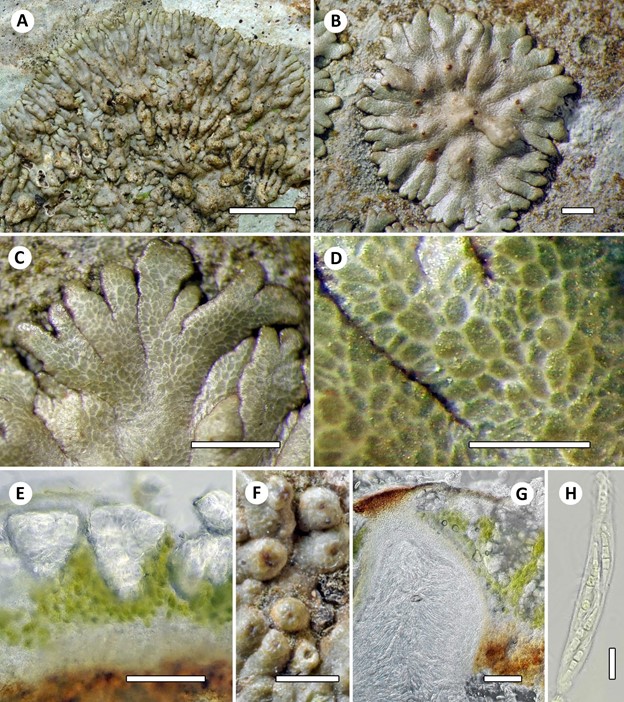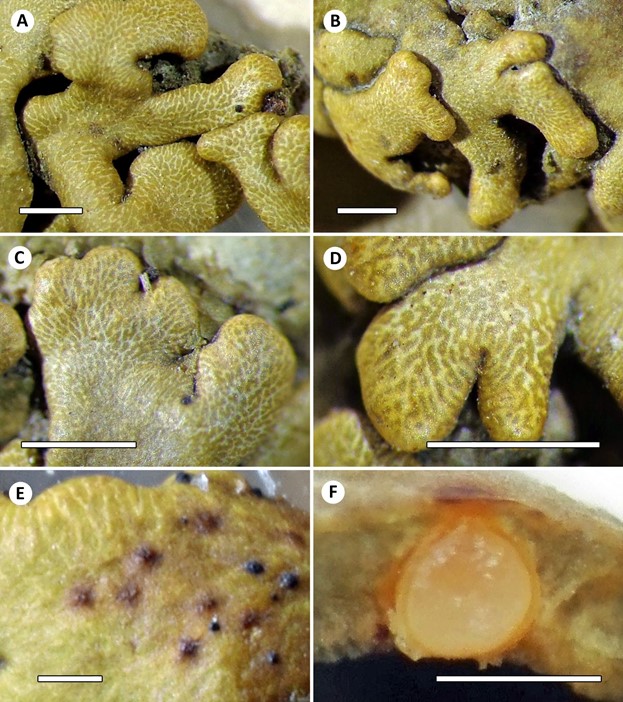Saxiloba Lücking, Moncada & Viñas, gen. nov. (Figs 2–3)
Index Fungorum number: MB 835479; Facesoffungi number: FoF 13851
Diagnosis: A new genus in the family Porinaceae, characterized by a placodioid thallus with clusters of columnar crystals visible from above areoles separated by a network of reticulate to meandering lines with reddish perithecia and with small, transversely septate ascospores, growing on a rock.
Generic type: Saxiloba firmula (Nyl. ex Müller) Lücking, Moncada & Viñas.
Description: Thallus saxicolous, placodioid, convex with distinct marginal lobes, but densely appressed to the substrate; surface smooth, but with a distinct network of reticulate to meandering lines (best seen when hydrated). Photobiont Trentepohlia. Thallus in section with large, triangular to rhomboid crystal clusters embedded into the photobiont layer (somewhat appearing like teeth within gums), the photobiont layer developed horizon- tally beneath and vertically between the crystal clusters; above with a prosoplectenchymatous cortex and below with a medulla and a thick, dark brown hypothallus layer. Perithecia immersed to erumpent or somewhat prominent, largely covered by thallus, ostiolar area orange-red to cherry-red or dark reddish brown, lacking a thallus cover and slightly translucent; paraphyses and asci as in other genera of the family. Ascospores transversely 3–5-septate, small.
Etymology: Refers to the placodioid thallus with dis- tinct marginal lobes, apparently growing exclusively on a rock.
Distribution and ecology: Thus far only known from disjunct collections on islands in the Caribbean (Cuba, Isla de la Juventud, Puerto Rico) and the Hawaiian archipelago (Kauai); growing on calcareous or volcanic rock in shady to exposed situations.
Notes: – Within Porinaceae, the new genus Saxiloba is readily distinguished by its placodioid thallus with columnar clusters of crystals embedded in a network of reticulate to meandering lines when seen from above. The unique thallus morphology and anatomy correspond to its phylogenetic position on a separate, rather long branch. Notably, the largely thallus-covered perithecia of Saxiloba firmula resemble those of the larger second clade of the family, whereas those of S. hawaiiensis are more similar to those of red-fruited foliicolous species in the Phragmopeltheca clade.
Except for the occasionally present perithecia, which immediately reveals its systematic affinities, the genus would not be considered a member of Porinaceae, but bears resemblance with lichens in some other related and unrelated families. Most similar are certain species in the genus Leucodecton in the related family Graphidaceae, in particular L. phaeosporum (Rivas Plata et al. 2010; Rivas Plata & Lumbsch 2011), which are readily distinguished by the apothecioid, pore-like ascomata with apically thick-walled asci forming brown, muriform ascospores, and in the sterile state by the absence of distinct marginal lobes.
The particular thallus anatomy found in Saxiloba can be compared to what has been coined ‘window lichens’ (‘Fensterflechten’; Vogel 1955; Follmann 1965), in analogy to the ‘stone plants’ (‘Fensterpflanzen’) in the former family Mesembryanthemaceae (now Aizoaceae). This anatomy was redescribed in much detail from a presumably monospecific genus, Labyrintha implexa (Malcolm et al. 1995), recently recombined as Poeltidea implexa (Fryday & Hertel 2014), a rock-dwelling taxon in the unrelated family Lecideaceae. Malcolm et al. (1995) made no reference to the earlier treatments of ‘window lichens’ by Vogel (1995) and Follmann (1965), but Vondrák & Kubásek (2013) and Fryday & Hertel (2014) showed that this anatomy appears to have evolved in several unrelated lineages, although it is not frequent. Vertical stacks of algal cells separated by columnar crystal clusters or vertical stacks of fungal hyphae have been interpreted as an adaptation to xeric habitats and/or high solar insolation (Vondrák & Kubásek 2013; Fryday & Hertel 2014). This hypothesis seems to fit the Hawaiian species, Saxiloba hawaiiensis, whereas S. firmula grows more frequently in shady conditions. Under such conditions, one could also imagine the vertical crystals aid in light distribution across a thicker photobiont layer, thus enabling the accumulation of higher biomass under low light.

Figure 2. Habit of Saxiloba firmula. A – thallus on calcareous rock; B – young thallus with immature perithecia; C–D – thallus lobes hydrated (in D enlarged) to show crystal clusters embedded in a network of hyphae with the photobiont layer beneath; the crystals reflect the greenish color of the photobiont, whereas the pale color of the reticulate lines is caused by the upper cortex; E – thallus section showing disposition of crystal clusters, photobiont layer, upper cortex, medulla and hypothallus; F – perithecia; G – section through perithecium showing laterally covering thallus layer with details of crystal clusters H, ascus with ascospores. (A – Lücking et al. 41865; B–D – Lücking et al. 41891; E–G – Lücking & Moncada 45298; H – lectotype). Scales: A = 5 mm; B–C, F = 1 mm; D = 0.5 mm; E, G = 100 μm; H = 10 μm.

Figure 3. Habit of Saxiloba hawaiiensis (isotype). A–C – thallus fragments removed from basalt; D–E – thallus lobes enlarged to show meandering crystal clusters embedded in a network of hyphae with the photobiont layer beneath; the crystals reflect the greenish color of the photobiont, whereas the pale color of the reticulate lines is caused by the upper cortex; F – young thalli developing atop an old, decaying thallus portion. Scales: A–D = 1 mm; E–F = 0.5 mm.
Species
